Facilities Staff Turn Teachers
Employees co-teach Duke course on sustainable building practices

Standing atop Rubenstein Hall, Casey Collins looked around at a group of 15 students surveying the bright white roof of the building.
He posed a question: why did the roof need to be white in the first place?
Read More“The white is needed for the North Carolina heat because we want the reflectivity to be as high as possible to avoid heat absorption,” explained Collins, energy manager with Duke Facilities Management. “And you’ll notice the elevation of the roof moves water to storm drains, because if you have a flat roof, it will stagnate.”
This real-life lesson is a big part of the educational experience of Duke graduate students in the class “Building Energy on Campus: Evaluating Efficiency and Conservation Measures at Duke.” Collins and Steve Palumbo, director of facility operations, are co-teaching with associate professor of the practice Tim Johnson. Throughout the spring semester, Collins and Palumbo have provided expertise in energy use with their unique perspective of campus buildings and energy policies, which they help to oversee. It’s the third time they’re helping to teach the class.
“Students appreciate interacting with professionals who are doing the type of work they’ll be doing in a couple years when they’re in the workforce,” said Johnson, who also chairs the energy and environment concentration in the Nicholas School's Master of Environmental Management program. “There’s a lot of value in having Steve and Casey around to share how Facilities staff approach Duke’s environment.”
In addition to in-class teaching covering a variety of topics like sustainable building practices, Collins and Palumbo have led building tours to show off real-world implications at locations like Chiller Plant #2, Rubenstein Hall and Sanford. Another Facilities employee, Adem Gusa, assistant director of planning and design, was a guest speaker and talked about master planning on campus.
“We try to show how every person in a building has an impact on the carbon footprint and our response to that when executing Duke’s Climate Action Plan,” Collins said. “We’ll talk about everything from our experiences using different technologies to create a more efficient campus to the economics of the energy world.”
The ultimate goal of the class is to guide master’s students through compiling an energy audit of Rubenstein and Sanford, with final presentations to Collins and Palumbo offering ideas on areas of energy efficacy, modeling and financial savings.
Karan Gupta, a graduate student who took the class last year and now acts as a teaching assistant, said his experience with Collins and Palumbo provided invaluable real world experience that came into use last summer during a fellowship with the Environmental Defense Fund Climate Corps.
“I was working in a commercial office building looking for energy efficiency measures, and my experience from class meant from day one, I knew what I was doing with chillers, boilers and lighting systems,” Gupta said. “Many classes teach us theoretical aspects of energy use, but hearing about real experience brings a whole different and practice perspective we can put to use.”